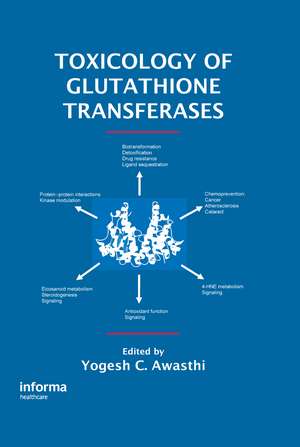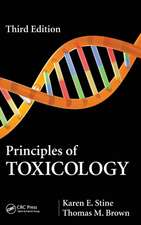Toxicology of Glutathione Transferases
Editat de Yogesh C. Awasthien Limba Engleză Hardback – 27 iul 2006
Chapters cover the possible and exciting role of GSTs in defense mechanisms against chronic oxidative stress-linked disorders such as atherosclerosis and the newly emerging area of GST-mediated modulation of stress-signaling through its catalytic as well as binding activities. They explore an intriguing hypothesis that strongly suggests an important role of the factors that modulate the GSH-electrophile conjugate (GS-E) homeostasis in the regulation of cellular processes. Chapters on known and potential endogenous electrophilic substrates and a major role of GSTs in suppressing stress-induced lipid peroxidation reinforce this newly emerging role of GSTs. These are just a few of the features that make the book helpful to clinicians involved in basic as well as tr
| Toate formatele și edițiile | Preț | Express |
|---|---|---|
| Paperback (1) | 499.58 lei 6-8 săpt. | |
| CRC Press – 23 oct 2019 | 499.58 lei 6-8 săpt. | |
| Hardback (1) | 1281.24 lei 6-8 săpt. | |
| CRC Press – 27 iul 2006 | 1281.24 lei 6-8 săpt. |
Preț: 1281.24 lei
Preț vechi: 1562.49 lei
-18% Nou
Puncte Express: 1922
Preț estimativ în valută:
245.24€ • 266.48$ • 206.14£
245.24€ • 266.48$ • 206.14£
Carte tipărită la comandă
Livrare economică 21 aprilie-05 mai
Preluare comenzi: 021 569.72.76
Specificații
ISBN-13: 9780849329838
ISBN-10: 0849329833
Pagini: 375
Ilustrații: 83 b/w images and 17 tables
Dimensiuni: 156 x 234 x 27 mm
Greutate: 0.7 kg
Ediția:1
Editura: CRC Press
Colecția CRC Press
ISBN-10: 0849329833
Pagini: 375
Ilustrații: 83 b/w images and 17 tables
Dimensiuni: 156 x 234 x 27 mm
Greutate: 0.7 kg
Ediția:1
Editura: CRC Press
Colecția CRC Press
Public țintă
Professional ReferenceCuprins
Preface.Ligandin and Glutathione S-Transferases; Historical Milestones. Families of Glutathione Transferases.Mammalian Glutathione S-Transferase Genes: Structure and Regulation. Combinatorial Protein Chemistry In Three Dimensions: A Paradigm For The Evolution Of Glutathione Transferases With Novel Activities. Substrates and Reaction Mechanisms of GSTs. Specificity of Glutathione S-Transferases in the Glutathione Conjugation of Carcinogenic Diol Epoxides. GST Polymorphism: Where To Now? Clinical Applications and Functional Analysis. Glutathione and Glutathione S-Transferases as Targets for Anticancer Drug Development.Physiological Substrates of Glutathione S-Transferases. Glutathione S-transferases as modulators of signal transduction. Glutathione-conjugate transport and Stress-Response Signaling: Role of RLIP76. Glutathione-S-Transferases and Oxidative Injury of Cardiovascular Tissues. Mitochondrial Glutathione S-Transferase Pool in Health and Disease. Activation of Microsomal Glutathione Transferase 1 in Toxicology. Glutathione S-transferase Isozyme Composition of Human Tissues. Enzymology of glutathione S-transferases: Laboratory Methods.
Descriere
The most important enzymes protecting human and other organisms from potentially toxic chemicals, Glutathione S-transferases (GSTs) are central to basic mechanisms such as stress response and physiological functions including protection against lipid peroxidation. This book describes the role of GST in toxicology, focusing on their pharmacologic and physiological roles and their relevance to biological toxicology. It covers structure and function, gene regulation, and these enzymes’ involvement in signal transduction. Reflecting current trends in this expanding research area, Toxicology of Glutathione Transferases is the only source that details the methods of GST research.







